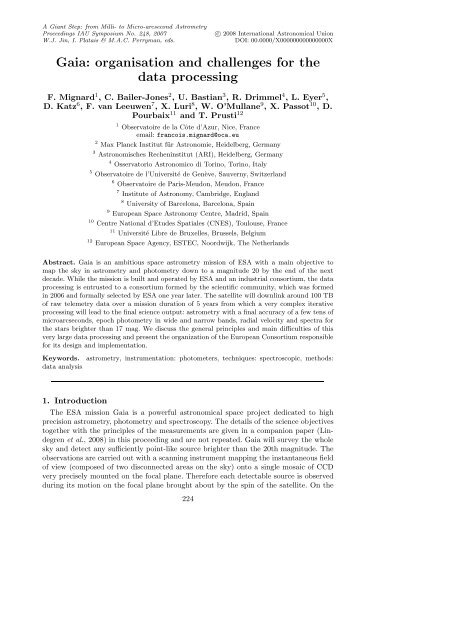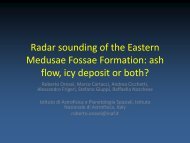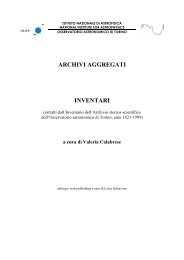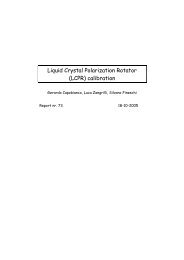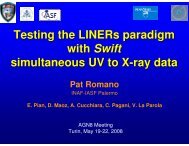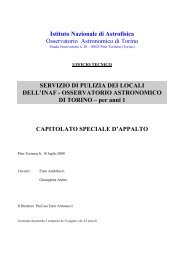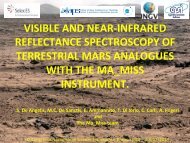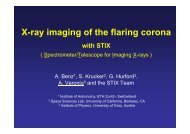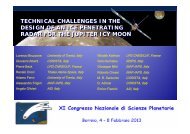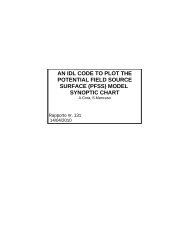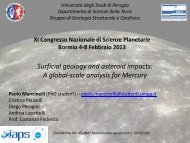Gaia - Osservatorio Astronomico di Torino
Gaia - Osservatorio Astronomico di Torino
Gaia - Osservatorio Astronomico di Torino
You also want an ePaper? Increase the reach of your titles
YUMPU automatically turns print PDFs into web optimized ePapers that Google loves.
A Giant Step: from Milli- to Micro-arcsecond Astrometry<br />
Procee<strong>di</strong>ngs IAU Symposium No. 248, 2007<br />
W.J. Jin, I. Platais & M.A.C. Perryman, eds.<br />
c○ 2008 International Astronomical Union<br />
DOI: 00.0000/X000000000000000X<br />
<strong>Gaia</strong>: organisation and challenges for the<br />
data processing<br />
F. Mignard 1 , C. Bailer-Jones 2 ,U.Bastian 3 ,R.Drimmel 4 ,L.Eyer 5 ,<br />
D. Katz 6 ,F.vanLeeuwen 7 ,X.Luri 8 , W. O’Mullane 9 ,X.Passot 10 ,D.<br />
Pourbaix 11 and T. Prusti 12<br />
1 Observatoire de la Côte d’Azur, Nice, France<br />
email: francois.mignard@oca.eu<br />
2 Max Planck Institut für Astronomie, Heidelberg, Germany<br />
3 Astronomisches Recheninstitut (ARI), Heidelberg, Germany<br />
4 <strong>Osservatorio</strong> <strong>Astronomico</strong> <strong>di</strong> <strong>Torino</strong>, <strong>Torino</strong>, Italy<br />
5 Observatoire de l’Université deGenève, Sauverny, Switzerland<br />
6 Observatoire de Paris-Meudon, Meudon, France<br />
7 Institute of Astronomy, Cambridge, England<br />
8 University of Barcelona, Barcelona, Spain<br />
9 European Space Astronomy Centre, Madrid, Spain<br />
10 Centre National d’Etudes Spatiales (CNES), Toulouse, France<br />
11 Université Libre de Bruxelles, Brussels, Belgium<br />
12 European Space Agency, ESTEC, Noordwijk, The Netherlands<br />
Abstract. <strong>Gaia</strong> is an ambitious space astrometry mission of ESA with a main objective to<br />
map the sky in astrometry and photometry down to a magnitude 20 by the end of the next<br />
decade. While the mission is built and operated by ESA and an industrial consortium, the data<br />
processing is entrusted to a consortium formed by the scientific community, which was formed<br />
in 2006 and formally selected by ESA one year later. The satellite will downlink around 100 TB<br />
of raw telemetry data over a mission duration of 5 years from which a very complex iterative<br />
processing will lead to the final science output: astrometry with a final accuracy of a few tens of<br />
microarcseconds, epoch photometry in wide and narrow bands, ra<strong>di</strong>al velocity and spectra for<br />
the stars brighter than 17 mag. We <strong>di</strong>scuss the general principles and main <strong>di</strong>fficulties of this<br />
very large data processing and present the organization of the European Consortium responsible<br />
for its design and implementation.<br />
Keywords.<br />
data analysis<br />
astrometry, instrumentation: photometers, techniques: spectroscopic, methods:<br />
1. Introduction<br />
The ESA mission <strong>Gaia</strong> is a powerful astronomical space project de<strong>di</strong>cated to high<br />
precision astrometry, photometry and spectroscopy. The details of the science objectives<br />
together with the principles of the measurements are given in a companion paper (Lindegren<br />
et al., 2008) in this procee<strong>di</strong>ng and are not repeated. <strong>Gaia</strong> will survey the whole<br />
sky and detect any sufficiently point-like source brighter than the 20th magnitude. The<br />
observations are carried out with a scanning instrument mapping the instantaneous field<br />
of view (composed of two <strong>di</strong>sconnected areas on the sky) onto a single mosaic of CCD<br />
very precisely mounted on the focal plane. Therefore each detectable source is observed<br />
during its motion on the focal plane brought about by the spin of the satellite. On the<br />
224
<strong>Gaia</strong> data processing 225<br />
average a source will transit about 80 times during the five years of the observing mission,<br />
lea<strong>di</strong>ng to about 1000 in<strong>di</strong>vidual observations per object. They will be more or less<br />
regularly <strong>di</strong>stributed over about ∼ 40 epochs with about one cluster of ∼ 25 in<strong>di</strong>vidual<br />
observations every 6 weeks. These observations consist primarily of a 1D accurate<br />
determination of the image location at the transit time on a frame rigidly attached to<br />
the payload together with an estimate of the source brightness. The number of sources<br />
potentially observable is of the order of one billion, primarily stars. In ad<strong>di</strong>tion there will<br />
be something like ∼ 5 × 10 5 QSOs and ∼ 3 × 10 5 solar system objects.<br />
2. Challenges with the data processing<br />
Scientifically valuable information gathered by <strong>Gaia</strong> during its lifetime will be encased<br />
in the nearly continuous data stream resulting from the collection of photons in the<br />
approximately 100 on-board CCDs in the astrometric, photometric and spectroscopic<br />
fields of <strong>Gaia</strong>. However in its original telemetry format the data are totally unintelligible<br />
to scientists, not only because it is squeezed into packets by the numerical co<strong>di</strong>ng but,<br />
more significantly, because of the way <strong>Gaia</strong> scans the sky. With a 1D measurement at<br />
each source transits, <strong>Gaia</strong> picks up tiny fragments of the astrometric parameters of the<br />
one billion observable sources in the sky. To translate this information into positional<br />
and physical parameters, as expected by scientists, a large and complex data analysis<br />
must be implemented. How huge and how complex it is, is briefly addressed here.<br />
2.1. Volume of data<br />
Data collected by the <strong>Gaia</strong> detectors will be transmitted by the spacecraft from its<br />
position around L2 at a few Mbps for at least five years. Over its lifetime the satellite<br />
will deliver to the ground station an uncompressed raw data set of approximately 100 TB,<br />
primarily composed of CCD counts collected during the transit of celestial sources on<br />
the detector. This will make up the raw data. However the data processing will generate<br />
numerous interme<strong>di</strong>ate data to produce the scientifically meaningful data products by<br />
2020. Given these interme<strong>di</strong>ate steps, the need to store the provisional solutions and<br />
<strong>di</strong>fferent backups, it is estimated that the actual size of the <strong>Gaia</strong> related data will be<br />
in the range of a PB (10 15 Bytes), still a fairly large volume by today’s standard, not<br />
yet matched by any other space mission, although ground based experiments in particle<br />
physics will produce data volume one or two orders of magnitude larger. It is enough to<br />
say that to store the text of all the books published each year a storage space of about<br />
1TB is sufficient which could be rea<strong>di</strong>ly available on anyone’s desk. An orderly access to<br />
this data is another question. For the astronomers accustomed to working with the CDS<br />
on-line data bases, all the catalogues stored in the VizieR service make less than 1 TB in<br />
<strong>di</strong>sk space, while the Ala<strong>di</strong>n sky atlas with the images is just above 5 TB. Despite this<br />
apparently limited volume, the administration and maintenance of these services require<br />
several permanent staff. Therefore, the volume alone is not a major issue, while efficient<br />
access to the relevant piece of data is a serious one.<br />
The core of the final data products <strong>di</strong>stributed to the scientific community will be much<br />
smaller. Scaling from Hipparcos with 10 5 sources with all the results on a few CDs, this<br />
should amount for <strong>Gaia</strong> to something around 20 TB of data. This depends very much on<br />
whether raw or nearly raw data are included in the delivery. If one considers just the final<br />
data of astrometry, photometry and spectroscopy (not the spectra but their exploitation<br />
in terms of ra<strong>di</strong>al velocity and astrophysical <strong>di</strong>agnostic), all the <strong>Gaia</strong> data expected for<br />
a standard user can be estimated by considering a data base with 10 9 entries, each of<br />
them comprising less than 100 fields. The astrometric data will need many significant
226 F. Mignard et al.<br />
<strong>di</strong>gits (or bytes), but most of the other fields will require a limited number of <strong>di</strong>gits<br />
or bits. A volume of 1-3 TB should then be sufficient for the main <strong>Gaia</strong> product, not<br />
inclu<strong>di</strong>ng data produced during the interme<strong>di</strong>ate steps of the data processing. These data<br />
will certainly be made available with calibration data to allow specific reprocessing with<br />
improved models by users.<br />
2.2. Computational complexity<br />
There is no all-purpose definition of what a complex computation is. It could be complex<br />
because of the number of elementary operations it requires (time complexity), or because<br />
of the data management (interface complexity), or because of the size of the core memory<br />
needed to perform some parts (space complexity). <strong>Gaia</strong> can be considered complex at<br />
least on two counts:<br />
• It implies a very large resource of CPU, or more or less equivalently, the number of<br />
basic arithmetical operations is very large by today’s standards, and will remain large in<br />
the coming ten years.<br />
• The data are widely interconnected with access sometimes to subsets arranged in<br />
chronological order (observations of a certain type in a certain time interval) or by sources<br />
(all the observations of a subset of sources). This extends to the access of interme<strong>di</strong>ate<br />
data or calibration files.<br />
What is at stake can be easily grasped if we consider that there will be about 10 9<br />
in<strong>di</strong>vidual sources to be processed. Just spen<strong>di</strong>ng one second on each of them to get the<br />
calibrations, spacecraft attitude, astrometric parameters, multi-color photometry and<br />
spectra would amount to 30 years of computation. Obviously the overall system must be<br />
very efficient to have a chance to produce the scientific results no longer than in three<br />
years after the end of the operations.<br />
As to the actual computation size, it is not easy to assess with reliability within at least<br />
one order of magnitude as shown already in 2004 by M. Perryman (Perryman, 2004).<br />
However we have now a better view with scalable experiments on simulated data. The<br />
core iterative processing needs (referred as to AGIS) have been evaluated by Lammers<br />
(Lammers, 2006) to 4 × 10 19 FLOPs for the last cycle, when all the observation material<br />
is available. Allowing for the interme<strong>di</strong>ate cycles this yields 2×10 20 FLOPs for the astrometric<br />
processing once the image parameters task and source matching are completed.<br />
This latter processing has also been evaluated from realistic simulated telemetry and<br />
should not be larger than 4 × 10 18 FLOPs for the full telemetry volume. Regar<strong>di</strong>ng the<br />
other processing (complex sources, photometry, spectroscopy and before all the image<br />
updating) the uncertainty remains significant and depends also on how much ad<strong>di</strong>tional<br />
modelling will be required to account for the ra<strong>di</strong>ation effect on the CCDs. A conservative<br />
estimate in<strong>di</strong>cates that the most deman<strong>di</strong>ng task will be the image updating (improvement<br />
of the image parameters and initial centroi<strong>di</strong>ng once a better spacecraft attitude<br />
and calibrations are known). It is estimated to be of the order of 10 21 FLOPs. But with<br />
numerous small computations repeated on all the sources instead of a global adjustment<br />
requiring a big core memory access, this deman<strong>di</strong>ng subsystem could be either <strong>di</strong>stributed<br />
or implemented with a parallel architecture.<br />
The number of 10 21 FLOPs happens to be very close to the largest computations<br />
undertaken so far, like a search of the largest prime numbers or the location of the<br />
non trivial zeros of the Riemann ζ function. The recent <strong>di</strong>stributed computation for<br />
the protein structure (FAH, 2007) is also in the same area in terms of computing size.<br />
However these computations are very <strong>di</strong>fferent from <strong>Gaia</strong>’s, since they are <strong>di</strong>stributed
<strong>Gaia</strong> data processing 227<br />
daily<br />
~ 6 months<br />
irregular<br />
<strong>Gaia</strong> S/C<br />
Telemetry<br />
Telemetry<br />
Ground station<br />
Telecommands<br />
House Keeping<br />
Reference data<br />
Raw data<br />
Science Center<br />
@ ESAC<br />
Initial data treatment<br />
First look<br />
First Look Reports<br />
Command file<br />
Orbit data, S/C data<br />
F/L Results<br />
Mission Control<br />
@ ESOC<br />
Simulation<br />
Raw data base<br />
daily storage<br />
Image parameters<br />
Image update<br />
AGIS<br />
Ast. Valid.<br />
Main data base<br />
version n<br />
Objects Photom. Spectro.<br />
Variability<br />
Ast. Param.<br />
<strong>Gaia</strong> products<br />
version n-1<br />
Figure 1. Main structure of the data flow in the processing of the <strong>Gaia</strong> raw data.<br />
through internet on several thousands processing units of small power (and cheap) and<br />
they do not have significant data handling. They are pure computations where each unit<br />
is given the task of making a tiny contribution. Most of the <strong>Gaia</strong> computations cannot<br />
be <strong>di</strong>stributed in this way and each computing center will have to access a large amount<br />
of data with a significant I/O overhead.<br />
By the time <strong>Gaia</strong> flies the computing power available to the <strong>Gaia</strong> Data Processing<br />
Centers is expected to be close to 10-20 TFLOP/s on large clusters. In ad<strong>di</strong>tion one<br />
can also count on the part-time availability of the Barcelona Super Computer (Mare<br />
Nostrum) which has a today’s power of 20 TFLOP/s. A straight evaluation for <strong>Gaia</strong> tells<br />
that about 2 full years of CPU at 20 TFLOP/s will be sufficient to process the data.<br />
This is still daunting but tractable, provided the estimate is not wrong by two orders of<br />
magnitude.<br />
3. Overview of the data processing<br />
The <strong>Gaia</strong> data processing is based on an iterative self-calibrating procedure where the<br />
astrometric core solution is the single largest treatment and the cornerstone of the whole<br />
processing. These iterations reflect the fact that, as a survey satellite reaches the accuracy<br />
and completeness levels never obtained before, it has to be self-calibrated in nearly all<br />
aspects of its observations. The most obvious in this respect are the astrometric data: the<br />
same data that will ultimately form the astrometric catalogue are also used to reconstruct<br />
the scan-phase of the satellite (along-the-scan attitude), which is the reference frame for<br />
the astrometric measurements. Similar considerations apply to the spectroscopic and<br />
photometric data. Ad<strong>di</strong>tional complications arise from the fact that these three main<br />
iterative solutions are in various ways interlinked and rely on common calibration data.<br />
The overall processing starts with an initial data treatment aiming to obtain a first<br />
estimate of the star positions and magnitudes together with an initial attitude, primarily
228 F. Mignard et al.<br />
based on the on-board crude determination improved on the ground with more accurate<br />
(and more computer greedy) algorithms. The next step is the iterative astrometric core<br />
solution which provides the calibration data and attitude solution needed for all the<br />
other treatments, in ad<strong>di</strong>tion to the astrometric solution of about 100 million primary<br />
sources and the rigid reference system. Once these two steps are performed and their<br />
products stored in the central data base, the more specialized tasks are launched with the<br />
photometric processing and variability detection, the global analysis of the spectroscopic<br />
data and the data treatment for all <strong>di</strong>fficult sources, like planets and multiple stars, that<br />
do not fit in the general astrometric or photometric solution of single stars. Two more<br />
processing steps close the chain, dealing with the analysis of all types of variable stars<br />
and retrieval of their stellar astrophysical parameters like luminosity, temperature or<br />
chemical composition. Each step in the processing using earlier data has its own logic<br />
regar<strong>di</strong>ng the products it will deliver, but that must be seen as part of the validation<br />
of the upstream processes. The overall data flow from telemetry to the final products is<br />
sketched in Fig. 1. The daily flow follows naturally from the data downlink taking place<br />
once per day during the visibility of L2 above the ESA main station in Spain.<br />
The data exchange between the <strong>di</strong>fferent processing centers (DPCs) takes place via a<br />
Main Database (MDB) hosted at a single place. Interme<strong>di</strong>ate processed data from the<br />
processing centers flow into the MDB; the processing centers can then extract the data<br />
from this Database for further processing. Thus, the Main Database acts as the hub for<br />
the <strong>Gaia</strong> data processing system and must have an efficient and reliable connection with<br />
all the DPCs. During operations, the plan is to update this database at regular intervals,<br />
typically every six months, correspon<strong>di</strong>ng roughly to the period for the satellite to scan<br />
the whole celestial sphere. In this way each version of the Main Database is derived from<br />
the data in the previous version, supplemented with the processed new observations.<br />
Table 1. Coor<strong>di</strong>nation Units of the DPAC and their current leader.<br />
CU Name Leader Affiliation Location<br />
CU1 System Architecture W. O’Mullane ESAC Madrid<br />
CU2 Simulation X. Luri UB Barcelona<br />
CU3 Core processing U. Bastian ARI Heidelberg<br />
CU4 Object processing D. Pourbaix ULB Brussels<br />
CU5 Photometric processing F. van Leeuwen IOAC Cambridge<br />
CU6 Spectroscopic processing D. Katz OBSPM Paris<br />
CU7 Variability processing L. Eyer Obs. Geneva Geneva<br />
CU8 Astrophysical parameters C. Bailer-Jones MPIA Heidelberg<br />
4. Organization of the scientific community<br />
To cope with the processing challenge, the scientific community, together with ESA,<br />
has set up a data processing ground segment comprising a single processing system<br />
(no overall duplication) which will deliver the interme<strong>di</strong>ate and final mission science<br />
products. Since mission selection, the underlying principles of the data processing have<br />
been developed by the <strong>Gaia</strong> scientific community and in<strong>di</strong>vidual pieces were successfully<br />
tested on small or interme<strong>di</strong>ate size simulations. During this phase one has attempted<br />
to identify the critical elements of this processing (size, iterative procedures, instrument
<strong>Gaia</strong> data processing 229<br />
calibration, data exchange, human and financial resources, computing power) and assess<br />
the risks inherent to an endeavor of that size, unprecedented in astronomy.<br />
Based on these preparatory activities the community has joined forces into a de<strong>di</strong>cated<br />
consortium: the Data Processing and Analysis Consortium (the DPAC). In short, the<br />
DPAC is a European collaboration inclu<strong>di</strong>ng the ESA <strong>Gaia</strong> Science Operations Centre<br />
(SOC) and a broad, international science community of over 320 in<strong>di</strong>viduals, <strong>di</strong>stributed<br />
over more than 15 countries, inclu<strong>di</strong>ng six large Data Processing Centers (DPCs, Table 2).<br />
The Consortium has carefully estimated the effort required and has united in a single<br />
organization the material, financial and human resources, plus appropriate expertise,<br />
needed to conduct this processing to its completion in around 2020. In 2006 the DPAC<br />
has proposed to ESA a complete data processing system capable of handling the full size<br />
and complexity of the real data within the tight schedule of the mission. The details of this<br />
system, its expected performances, fun<strong>di</strong>ng, organization and management are described<br />
in a document submitted to ESA as a Response to its Announcement of Opportunity for<br />
the <strong>Gaia</strong> data processing (Mignard et al., 2007).<br />
<strong>Gaia</strong> Project Team<br />
DPACE<br />
<strong>Gaia</strong> Project Scientist<br />
CU1<br />
System<br />
Architecture<br />
Coor<strong>di</strong>nation Units<br />
<strong>Gaia</strong> Science Team<br />
CU2<br />
CU3<br />
CU4<br />
CU5<br />
CU6<br />
CU7<br />
CU8<br />
Simulation<br />
Core<br />
Processing<br />
Object<br />
Processing<br />
Photometric<br />
Processing<br />
Spectroscopic<br />
Processing<br />
Variability<br />
Processing<br />
Astrophysical<br />
Parameters<br />
DPC<br />
ESAC<br />
DPC<br />
Barcelona<br />
DPC<br />
<strong>Torino</strong><br />
DPC<br />
Cambridge<br />
DPC<br />
Geneva<br />
DPC<br />
CNES<br />
Data Processing Centers<br />
Figure 2. Top level structure of the DPAC with the Coor<strong>di</strong>nation Units (CUs) and the data<br />
processing centers (DPCs). Colored connectors in<strong>di</strong>cate the link between the CUs and the DPCs.<br />
The Consortium is structured around a set of eight Coor<strong>di</strong>nation Units (CUs) each<br />
in charge of a specific aspect of the data processing. The CUs are the buil<strong>di</strong>ng blocks<br />
of the <strong>Gaia</strong> Data Processing and Analysis Consortium and they are listed together with<br />
their leader’s name in Table 1. An ad<strong>di</strong>tional CU (the CU9) in charge of developing the<br />
tools for the Catalogue access by the scientific community is planned in the near future<br />
but is not yet activated. The CUs have clearly-defined responsibilities and interfaces,<br />
and their boundaries match naturally with the main relationships between tasks and<br />
the associated data flow. Responsibilities of the coor<strong>di</strong>nation units include: (a) defining<br />
data processing tasks and assigning responsibilities; (b) establishing development priorities;<br />
(c) optimizing, testing and implementing algorithms; (d) verifying the quality of<br />
the science products. Each coor<strong>di</strong>nation unit is headed by a scientific manager (the CU<br />
leader) assisted by one or two deputies and, where appropriate, a technical manager. The<br />
management team of each CU is responsible for acquiring and managing the resources
230 F. Mignard et al.<br />
needed for their activities. While the CUs are primarily structured for software development,<br />
all of them are closely associated with at least one DPC where the algorithms will<br />
be executed for the data processing in the operational phases.<br />
The Consortium is coor<strong>di</strong>nated by the ‘Data Processing and Analysis Consortium<br />
Executive’ (DPACE) committee. This top-level management structure deals with matters<br />
that are not specific to the internal management of a CU, defining standards and policies<br />
needed to ensure an efficient interaction between all the CUs. Consistent with the Science<br />
Management Plan, the DPACE and its chair will serve as an interface between the DPAC<br />
and the Project Scientist and the <strong>Gaia</strong> Science Team. They are ultimately responsible<br />
for the data processing carried out by the DPAC. This executive committee is composed<br />
at the moment of the DPAC chair and deputy, the leaders of each CU, a representative<br />
of the CNES Data Processing Center. The <strong>Gaia</strong> Project Scientist (an ESA position) has<br />
a stan<strong>di</strong>ng invitation to the DPACE where he has the status of observer.<br />
Table 2. The Data Processing Centres associated to the DPAC, their current manager and<br />
involvement.<br />
DPC Location Manager Linked to:<br />
DPC-B Barcelona S. Girona CU2, CU3<br />
DPC-C CNES X. Passot CU2, CU4, CU6, CU8<br />
DPC-E ESAC J. Hoar CU1, CU3<br />
DPC-G Geneva M. Beck CU7<br />
DPC-I Cambridge F. van Leeuwen CU5<br />
DPC-T <strong>Torino</strong> A. Volpicelli CU3<br />
The DPAC has responded to the Announcement of Opportunity released by ESA on<br />
9 November 2006. The Response document contains, in an hefty volume of more than<br />
650 pages, the overall description of the <strong>Gaia</strong> data processing to reach the scientific<br />
objectives, the organization of the consortium and the fun<strong>di</strong>ng commitments of the national<br />
agencies supporting the DPAC. This response has been reviewed by various ESA<br />
advisory committees and after one iteration the DPAC proposal and its selection have<br />
been formally endorsed by the ESA Science Program Committee in its meeting of May<br />
2007. In November 2007 the same high level committee has also approved the fun<strong>di</strong>ng<br />
agreement between the national agencies and ESA.<br />
Acknowledgements<br />
This short review of the DPAC organization and activities relies heavily on the contribution<br />
of many members of the DPAC who are collectively gratefully acknowledged for<br />
their de<strong>di</strong>cation to the project.<br />
References<br />
FAH, 2007, http://fol<strong>di</strong>ng.stanford.edu/<br />
Lammers, U., 2006, Agis technical report, GAIA-C1-PR-ESAC-UL-018-1.<br />
Lindegren, L., et al., 2008, this volume p.217<br />
Mignard, F., et al., 2007, Proposal for the <strong>Gaia</strong> Data Processing, GAIA-CD-SP-DPAC-FM-030-<br />
2, Mignard, F., Drimmel, eds.<br />
Perryman, M., 2004, Estimation of <strong>Gaia</strong> Data Processing FLOPs, GAIA-MP-009.


